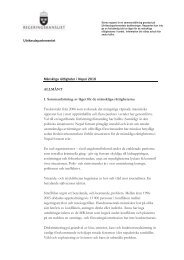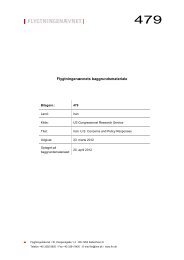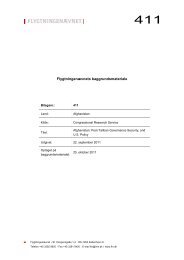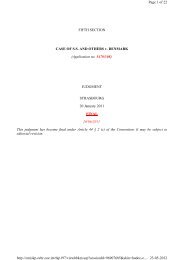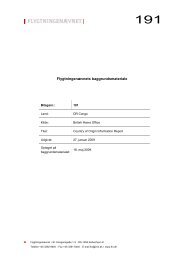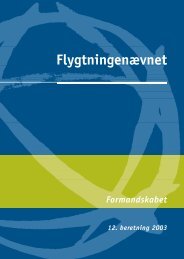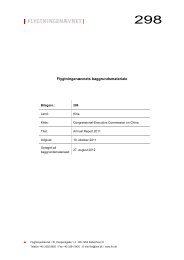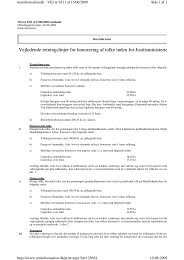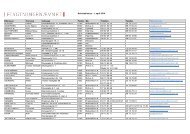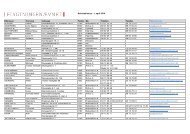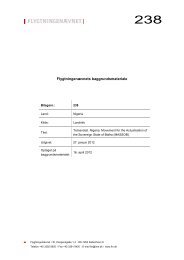Annual Report - National Human Rights Commission
Annual Report - National Human Rights Commission
Annual Report - National Human Rights Commission
You also want an ePaper? Increase the reach of your titles
YUMPU automatically turns print PDFs into web optimized ePapers that Google loves.
Annexure 12<br />
○ ○ ○ ○ ○ ○ ○ ○ ○ ○ ○ ○ ○ ○ ○ ○ ○ ○ ○ ○ ○ ○ ○ ○ ○ ○ ○ ○ ○ ○ ○ ○ ○ ○ ○ ○ ○ ○ ○ ○ ○ ○ ○ ○ ○ ○ ○ ○ ○ ○ ○ ○ ○ ○ ○ ○ ○ ○ ○ ○ ○<br />
○<br />
conformity with the human rights of the survivor/victim. They should also specify the<br />
accountability of the agencies concerned in providing services. These guidelines should not be<br />
confined to law enforcement and justice delivery, but also extend to prescribing minimum standards<br />
with respect to prevention, rehabilitation, counselling, providing livelihood options, economic<br />
and social empowerment, etc. These are grey areas in which many stakeholders find it difficult<br />
to function effectively for want of appropriate orientation. For example, the girls rescued in<br />
2002 in Delhi were from different states in India. The government officials of NCT Delhi did try<br />
their best to network with the officials of the concerned state governments. Though many states<br />
cooperated, some did not. However, after the High Court intervened, things moved in a positive<br />
direction. Perhaps appropriate guidelines on such issues would have made the situation easier<br />
and facilitated in the protection of rights of all concerned. Considering the fact that this is an area<br />
where the central government and all state governments are involved, it would be appropriate to<br />
prepare these guidelines of minimum standards of care under the aegis of NHRC and thereupon,<br />
the state governments could incorporate them in the rules to be issued under ITPA and the<br />
Government of India could incorporate them in the NPA.<br />
Multidisciplinary Approach in Combating Trafficking<br />
The Constitution of India, under Article 23, explicitly prohibits trafficking for any type of<br />
exploitation, including commercial sexual exploitation, labour and servitude. Research has shown<br />
that issues relating to trafficking in women and children cut across departments, agencies and all<br />
such boundaries, but the response from governmental and other agencies has been sectarian,<br />
segmented and, usually, unidimensional. Anti-trafficking activities should, therefore, be integrated<br />
into polices, programmes and projects of all ministries and departments which have any bearing<br />
on the issues concerned with or related not only to trafficked persons but also to the persons who<br />
are vulnerable to trafficking. It calls for a multidisciplinary integrated approach by all the concerned<br />
government agencies.<br />
<strong>National</strong> Nodal Agency<br />
The research has brought out the wide gap between the various government agencies at the<br />
centre and in the states in addressing the problems related to trafficking. A national nodal agency<br />
to counter human trafficking needs to be set up, by integrating the anti-trafficking activities of<br />
the central government and state governments, especially involving the departments of women<br />
and child, labour, social justice, health, home, tourism, railways, information and broadcasting,<br />
law and justice, and agencies like NACO and CBI. An MOU among these agencies, perhaps<br />
taking cue from the Thailand MOU, may be required for effective coordination. Since an<br />
amendment of the ITPA is in the pipeline, this nodal agency could be built into the Act itself.<br />
Considering the fact that this involves the central government and all state governments, it would<br />
be appropriate if this is set up by DWCD under the aegis of the NHRC. The state governments,<br />
as advised by the NHRC during this research, have already earmarked two nodal officers in<br />
each state (one representing the police and the other representing the welfare/women and child<br />
development departments). Integrating them into the proposed national nodal agency could<br />
<strong>National</strong> <strong>Human</strong> <strong>Rights</strong> <strong>Commission</strong> <strong>Annual</strong> <strong>Report</strong> - 2004-2005<br />
271<br />
AR-Chapter-1-19-10-6-06.p65<br />
291<br />
7/17/06, 6:31 PM



